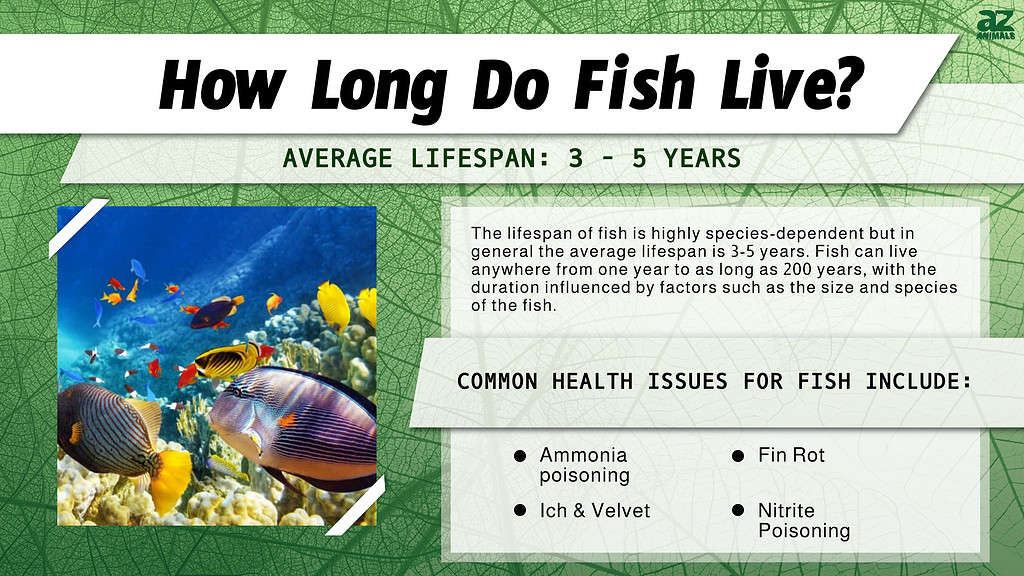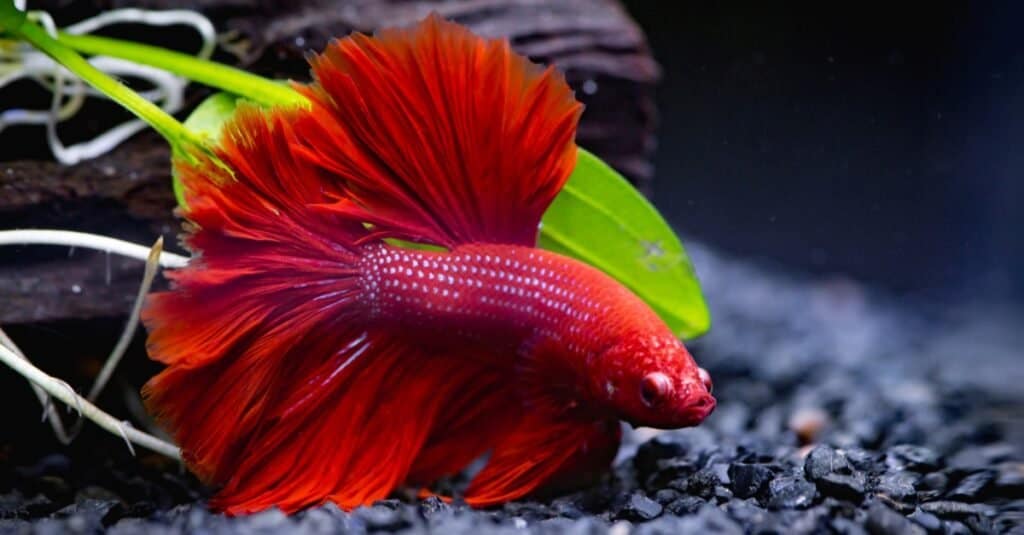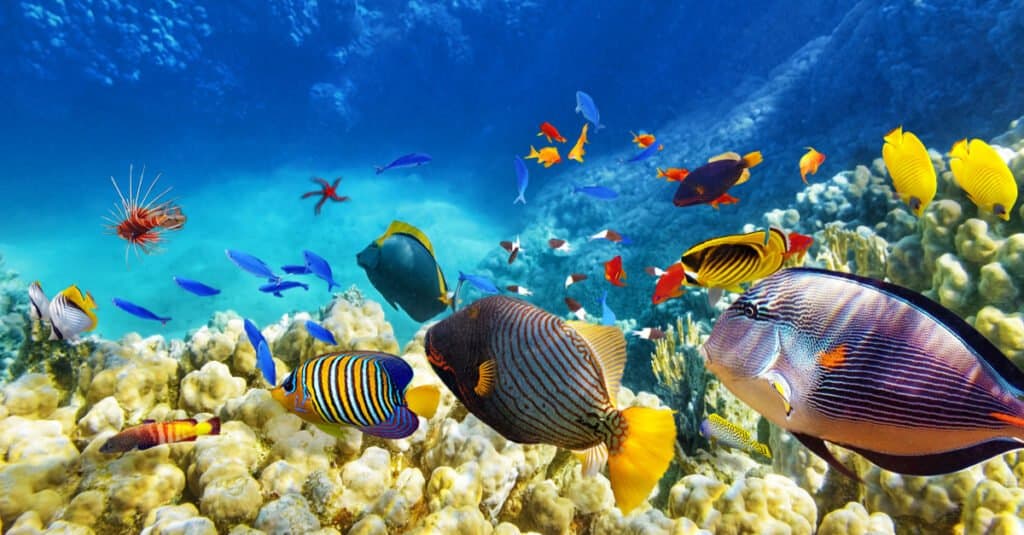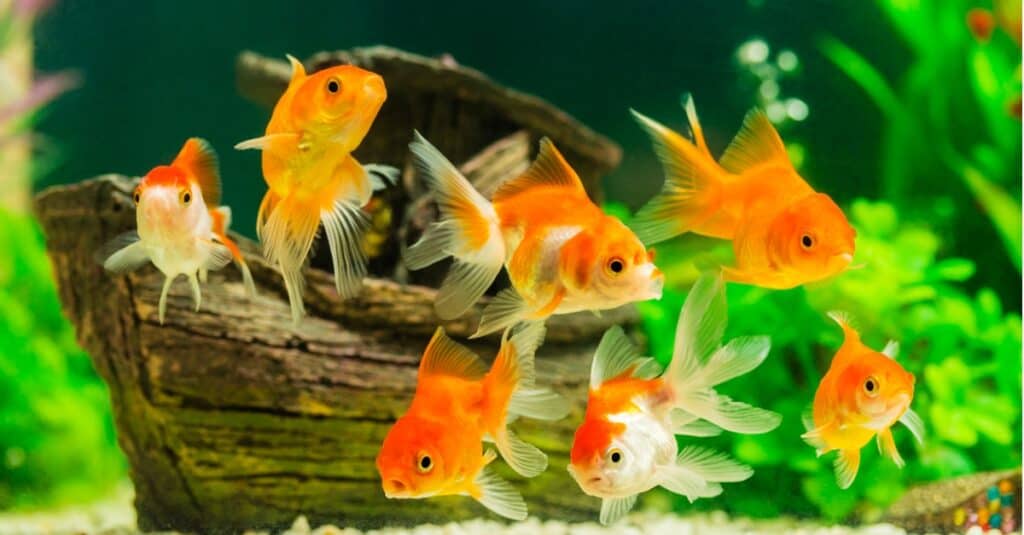
As one of the oldest inhabitants on the earth, fish have been around for a long time. Found in both fresh and saltwater, fish are one of the most abundant species on the planet. It would be difficult to find aquatic habitats that don’t house these vertebrates!
As such an interesting, ancient species it makes sense that we would be curious about just how long they live. In this article, we’ll cover what the average fish lifespan is and how long fish live both in the wild and in captivity. Let’s discover what makes this species so interesting!
A Quick Rundown on the Fish Species

The first vertebrates on Earth were fish.
©ANURAK PONGPATIMET/Shutterstock.com
Fish have been around for the last 530 million years. They existed long before Dinosaurs ever inhabited the earth. They are classified as aquatic vertebrates and have common external anatomy parts such as gills, fins, scales, and a mouth. The term fish applies to a wide variety of aquatic animals and these include sharks, stingrays, puffers, eels, seahorses, and clownfish.
There are currently over 30,000 different species of fish. However, the total number of fish species is still not fully known to this day. We may discover another 10,000 species in the years to come!
How Long Do Fish Live?

There are over 30,000 discovered species of fish.
©V_E/Shutterstock.com
The fish lifespan varies by species. On average, fish can live anywhere between a year to 200 years depending on the size and species of the fish. Whether they live in the wild or in captivity will also play a role.
For example, the majority of wild freshwater fish average anywhere between 1 to 10 years of life. Fantail guppies, rainbow fish, hatchet fish, corydoras catfish, and tiger barbs can live between 1-3 years. Betas and Jack Dempsey fish can average anywhere between 3-5 years. Meanwhile, angelfish can live up to 10 years on average.
Wild saltwater fish, on the other hand, are capable of living many years. The life expectancy of marine fish is anywhere between a year and a century. However, you will find anomalies such as Hanako, a koi fish that is said to have lived to 226 years old, and the Greenland shark which lived to be 392-years-old.
In general, the life expectancy of saltwater fish kept as a pet is around 20 years. Pet freshwater fish tend to live to about 15 years. Research done by the University of Michigan Museum of Zoology, pet goldfish have been recorded to live up to 25 years when kept in ideal conditions.
The Fish Life Cycle Explained
The life cycles of fish differ depending on the species. In general, however, fish go through the following stages in their life cycle:
Egg
Fertilized eggs hatch into fish. During this stage of development, the egg will begin to develop organs such as eyes and a tail. Sadly, even under the most ideal conditions, the majority of eggs will not survive to hatch. This is because there are many threats to eggs that include water temperature and oxygen level changes, predators, and disease.
Larvae
When the eggs hatch, they are referred to as larva. A yolk sac is present in new larvae. They get their sustenance from the yolk sac. The larva may survive for 2-4 days on the food supply of the yolk sac. Once their eyes and lips have formed, they can be given a live feed.
Fry

Fry fish are usually 5-10 weeks old and swimming.
©phasaluka/Shutterstock.com
Once the yolk sac has been completely dissolved, the young fish are referred to as fry. At this point, they are ready to begin feeding on their own. Fish go through numerous stages of growth. They are known as fry during the first few months.
Juvenile
The larval stage comes to an end once the fry undergoes a metamorphosis. During this stage, fishes develop adult-like traits such as fins, color, body components, and so on, and they are classified as juveniles.
Adult
When a fish is able to breed, it is considered an adult. The time necessary for a fish to mature varies depending on the species and the individual fish. Fish with shorter life spans mature quicker. Female round gobies, for example, mature in about a year and live for two to three years. In comparison, the lake sturgeon may live for 80-150 years, but females do not attain maturity until they are about 25 years old.
What are the Most Common Causes for A Fish’s Death?
As one of the oldest inhabitants on the earth, fish are incredibly important to our ecosystem. This is why maintaining the fish population is necessary for all life on the planet. There are several factors that could spell out death for fish that live in the wild. These include abrupt temperature changes, pollution or contamination of waters, diseases, and predators.
Although fish kept in captivity will not have to worry about predators, they are susceptible to other issues. Luckily, most of the deaths caused to pet fish can be easily avoided. Issues such as overfeeding, purchasing the wrong tank, and excessive water changes can all result in the death of a pet fish.
How to Extend the Life of Your Pet Fish

Goldfish are one of the most common pet fish.
©iStock.com/satit_srihin
Over the years, fish have continued to grow in popularity as both a low maintenance and generally inexpensive pet. Pet fish need to be cared for properly just like any other pet. It might seem like all a fish needs is a tank and food but extending the life of your fish includes much more.
Let’s go over all the ways to best take care of your pet fish:
- New Tank Syndrome: New tanks do not start out with the appropriate chemistry to create a healthy environment for your pet fish. This means that heavy quantities of nitrates and ammonium can build up in the water. To avoid this, test a new tank for nitrate and ammonium levels on a regular basis, and replace the water as needed.
- Overfeeding: Fish don’t eat the same way we do. Overfeeding your fish can result in rotten food polluting the tank, in turn messing up the chemistry of the tank. To avoid this, create a feeding schedule and stick to it. Wait until the fish devour all of the food in 1-2 minutes and then stop.
- Temperature Changes: Although most fish can handle a wide variety of temperatures in the tank, abrupt or extreme temperature changes can create a stressful environment. This can make the fish susceptible to sickness. Check the tank heater on a regular basis and keep it away from heating or cooling vents.
The photo featured at the top of this post is © Vojce/Shutterstock.com
Thank you for reading! Have some feedback for us? Contact the AZ Animals editorial team.






